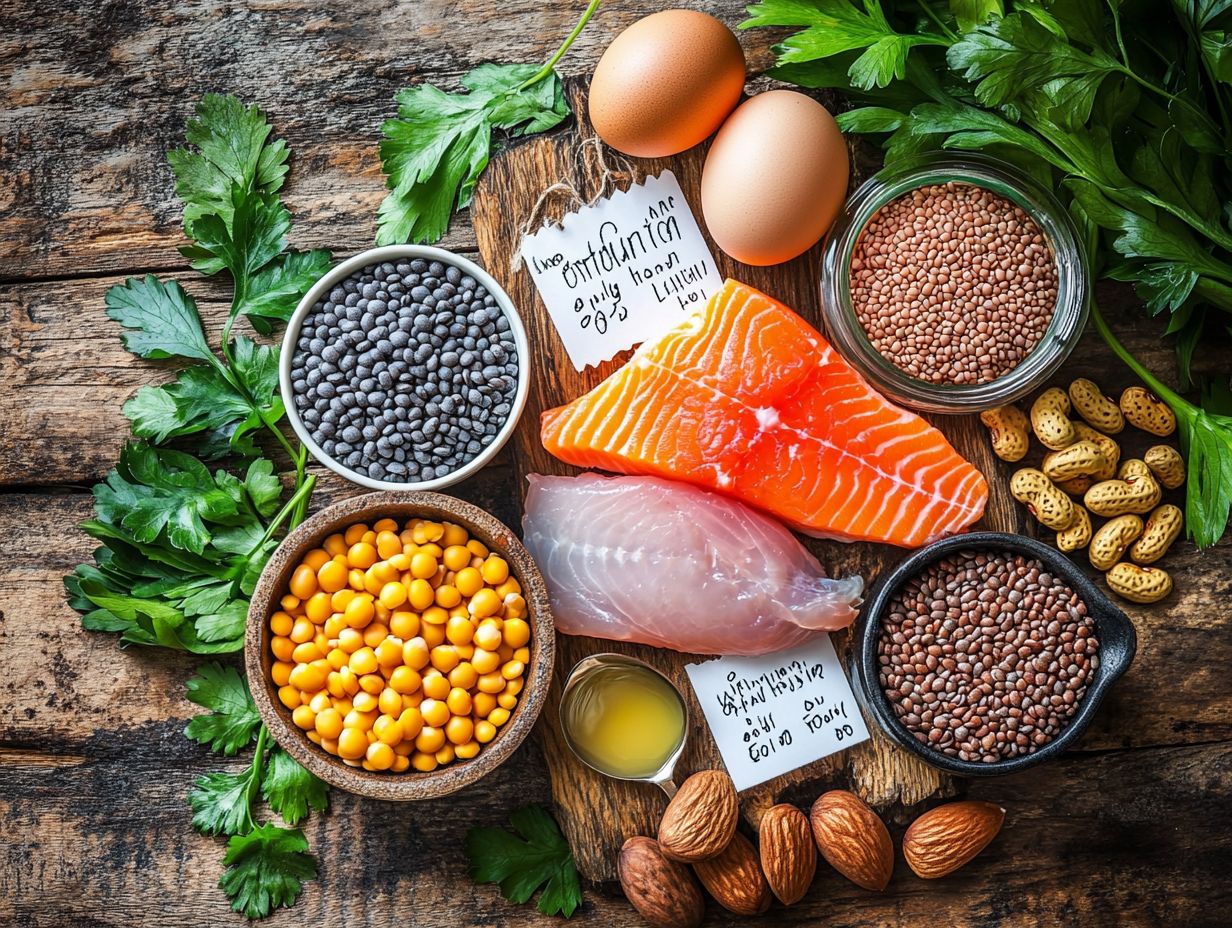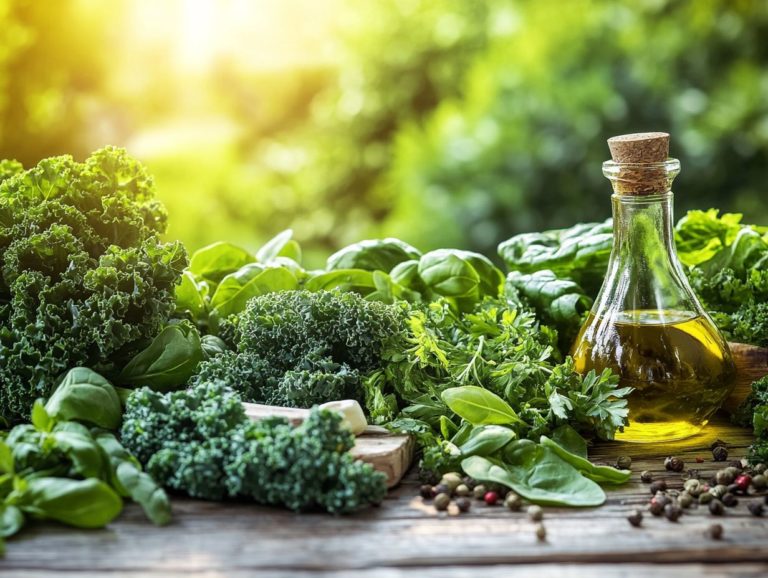Understanding Food Sources of Essential Amino Acids
Essential amino acids are crucial for your overall health, underpinning everything from muscle repair to immune function.
This article delves into what these amino acids are and their significance. It also explores how they vary across different protein sources. You will uncover the distinctions between complete and incomplete proteins. Rich food sources from both animal and plant origins will be showcased, along with tips on combining incomplete proteins for a well-rounded diet.
Prepare to elevate your nutritional knowledge and discover delicious ways to ensure you re obtaining all the essential amino acids your body requires.
Contents
Key Takeaways:

Essential amino acids are the building blocks of protein and play a crucial role in many bodily functions.
Animal-based proteins, such as meat, fish, and dairy, are complete protein sources, as they contain all essential amino acids.
Plant-based proteins, like beans, legumes, and grains, are often incomplete. They can be combined with other foods to create a complete amino acid profile.
What are Essential Amino Acids?
Essential amino acids are the fundamental building blocks of protein that your body cannot produce on its own. They are vital for various body functions, including muscle repair and protein synthesis.
These amino acids play a significant role in muscle function, which is crucial for physical activity and overall well-being. Without sufficient intake through your diet or supplementation, challenges in muscle growth, recovery, and even mood regulation may arise.
Understanding their importance can transform your meal planning and nutritional strategies, ultimately supporting a healthier lifestyle.
Definition and Importance
Grasping the definition and significance of essential amino acids is crucial for your nutrition and health.
These organic compounds, which your body cannot synthesize, must be sourced from your diet. They are essential for maintaining optimal body functions.
Essential amino acids are vital for muscle repair and growth, supporting your performance whether you re an athlete or a fitness enthusiast. They also contribute to your immune system, helping you fend off infections and diseases.
Essential amino acids also affect your mood and thinking. This underscores the need to incorporate dietary sources such as lean meats, dairy, eggs, and legumes to meet these nutrient needs.
Complete vs. Incomplete Protein Sources
When exploring protein sources, distinguishing between complete and incomplete proteins is crucial. This difference impacts your diet and nutrition.
Differentiating Between Sources

Differentiating between complete and incomplete protein sources is essential for meal planning and ensuring adequate nutrition. Understanding this distinction helps optimize your diet for muscle growth, weight management, and overall health.
Complete proteins such as fish, eggs, and meats contain all nine essential amino acids that your body cannot produce. In contrast, sources like beans and soy are classified as incomplete proteins because they lack one or more essential amino acids.
By thoughtfully combining different protein sources, such as pairing rice with beans or spreading nut butter on whole-grain toast, you can achieve a balanced amino acid profile. This approach enhances the nutritional value of your meals and supports your overall well-being.
Food Sources of Essential Amino Acids
You ll find that food sources of essential amino acids are plentiful, divided into two main categories: animal-based and plant-based proteins.
Each type brings unique nutritional advantages, enriching your diet in distinct ways. Start incorporating these foods today for a healthier tomorrow!
Animal-Based Protein Sources
Animal-based protein sources are among the richest providers of essential amino acids. They are a cornerstone of your nutrition.
These proteins, such as fish, eggs, and dairy products, offer a well-rounded amino acid profile crucial for various bodily functions. The omega-3 fatty acids found in fish promote heart health and play a significant role in reducing inflammation, aiding muscle recovery after exercise.
Eggs, often hailed as a complete protein source, provide all nine essential amino acids. These are beneficial for muscle maintenance and repair.
Meanwhile, dairy products like yogurt and cheese contribute not just protein but also calcium, supporting your bone health. Together, these sources enhance muscle function, facilitate wound healing, and expedite recovery from surgical procedures, making them essential in your balanced diet.
Plant-Based Protein Sources
Plant-based protein sources offer a wealth of essential amino acids. They are an excellent addition to your diet.
These options go beyond being protein-packed; choices like quinoa, soy, and various beans present a comprehensive nutritional profile that includes fiber, vitamins, and minerals. Quinoa, often celebrated as a superfood, provides complete protein vital for muscle recovery and overall well-being.
Soy products, such as tofu and tempeh, not only fuel your energy needs but may boost your mood. Their isoflavones are linked to enhanced mental well-being.
Beans, abundant in both fiber and plant-based protein, play a crucial role in stabilizing blood sugar levels. This offers you sustained energy throughout the day, making them invaluable for anyone looking to balance plant and animal proteins in their meals.
Combining Incomplete Proteins for a Complete Amino Acid Profile

By combining incomplete proteins, you can craft a complete amino acid profile essential for achieving optimal health and nutrition. This thoughtful approach ensures your body receives all the necessary building blocks it needs to thrive.
Tips and Recipes for Combining Proteins
To maximize the nutritional value of your meals, it s essential to integrate tips and recipes that help you combine proteins for a complete amino acid profile.
By selecting complementary protein sources like pairing legumes with grains or dairy with nuts you can significantly enhance your health benefits. Try a delicious quinoa and black bean salad to fuel your muscles and keep your energy high.
Employing these strategies can elevate your athletic performance, as your body s demand for diverse nutrients increases with activity. Consider exploring recipes like chickpea hummus served with whole-grain pita; this creates a delicious snack while ensuring a rich intake of vital amino acids, all while satisfying your taste buds.
Frequently Asked Questions
What are essential amino acids?
Essential amino acids are the building blocks of proteins that our bodies cannot produce on their own and must be obtained through food sources.
How many essential amino acids are there?

There are nine essential amino acids, including histidine, isoleucine, leucine, lysine, methionine, phenylalanine, threonine, tryptophan, and valine.
Why are essential amino acids important?
Essential amino acids are important for many bodily functions, including building and repairing tissues, producing hormones and enzymes, and supporting a healthy immune system.
What are some food sources of essential amino acids?
Food sources of essential amino acids include animal proteins such as meat, poultry, fish, eggs, and dairy products, as well as plant-based sources like beans, lentils, quinoa, and tofu.
Can vegetarians and vegans get all the essential amino acids they need?
Yes, vegetarians and vegans can obtain all the essential amino acids they need by incorporating a variety of plant-based protein sources into their diet. Combining different plant-based protein sources can also ensure a complete amino acid profile.
Explore more about amino acids to improve your health and well-being!
What are the consequences of not consuming enough essential amino acids?
Essential amino acids are the building blocks of protein that our bodies need but can t produce on their own. Not getting enough of them can cause protein deficiency.
This deficiency can lead to fatigue, muscle weakness, and a weakened immune system. Don t wait to balance your diet ensure you re getting all essential amino acids for your health!






